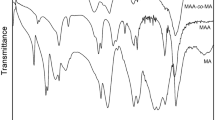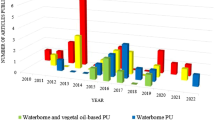Abstract
Urethane-modified alkyd resins were synthesized using the depolymerization intermediates obtained from simultaneous hydrolysis–glycolysis reactions of post-consumer poly(ethylene terephthalate) (PET) bottles with dipropylene glycol (DPG) and water. For this aim, first, the synthesis of a four-component reference alkyd resin having an oil content of 50% was synthesized by using tall oil fatty acid (TOFA), trimethylolpropane (TMP), phthalic anhydride (PA), and dipropylene glycol (DPG). The PET-based alkyd resins were also synthesized using different amounts and types of purified and fractionated depolymerization intermediates (water-insoluble fraction, WIF, and water-soluble and crystallizable fraction, WSCF) under the same reaction conditions. For the synthesis of PET-based alkyd resins, the depolymerization intermediates were used partially or completely instead of dibasic acid and/or diol components in alkyd resin formulations. In order to determine the optimum modification ratio for urethane-modified alkyd resin synthesis, the reference alkyd resin was reacted with toluene diisocyanate (TDI) at different molar ratios (NCO/OH: 1/1, 1/2, and 1/3), and the optimum NCO/OH ratio was determined as 1/1, according to the surface coating properties. And, then, all PET-based urethane-modified alkyd resins were prepared by the modification reactions of the PET-based alkyd resins with TDI at an optimum ratio. At the end of the study, it was observed that the use of waste PET intermediates (WIF or WSCF) did not cause any negative effects on physical/chemical surface coating and thermal properties; on the contrary, some properties were obtained as superior than that of the reference resin. In conclusion, it seems possible to use PET-based urethane-modified alkyd resin could be used as a cheap, environmentally friendly, and relatively economic binder component in synthetic paint formulations. In the synthesis of urethane-modified alkyd resin, using a certain amount of waste PET intermediate instead of dibasic acid and/or diol component will reduce raw material costs and also benefit the environment by re-evaluation of recycled PET. Thus, it could be both possible to recycle of post-consumer PET bottles, which are a valuable waste, and to provide cheap raw materials without compromising its features for paint formulations. These results are remarkable in terms of sustainability and waste management besides are also important for the economy and paint industry.
Graphical Abstract








Similar content being viewed by others
References
Saravari, O, Potiyaraj, P, Phunphoem, S, “Preparation of Urethane Oils from Microwave-Assisted Glycolyzed Products of Waste PET Bottles.” Energy Procedia, 9 491–497 (2011)
de Castro, AM, Carniel, A, Sirelli, L, Dias, ML, de Menezes, SMC, Junior, LSC, Honorato, HA, “Enzyme-Catalyzed Simultaneous Hydrolysis-Glycolysis Reactions Reveals Tunability on PET Depolymerization Products.” Biochem. Eng. J., 137 239–246 (2018)
Grause, G, Handa, T, Kameda, T, Mizoguchi, T, Yoshioka, T, “Effect of Temperature Management on the Hydrolytic Degradation of PET in a Calcium Oxide Filled Tube Reactor.” Chem. Eng. J., 166 (2) 523–528 (2011)
Cakić, SM, Ristić, IS, Milena, M, Nikolić, NČ, Ilić, OZ, Stojiljković, DT, B-Simedic, JK, “Glycolyzed Products from PET Waste and Their Application in Synthesis of Polyurethane Dispersions.” Prog. Org. Coat., 74 (1) 115–124 (2012)
Damayanti, D, Wu, HS, “Strategic Possibility Routes of Recycled PET.” Polymers, 13 (9) 1475 (2021)
Zhou, X, Wang, C, Fang, C, Yu, R, Li, Y, Lei, W, “Structure and Thermal Properties of Various Alcoholysis Products from Waste Poly(ethylene terephthalate).” Waste Manag., 85 164–174 (2019)
Tuna, Ö, Bal, A, Güçlü, G, “Investigation of the Effect of Hydrolysis Products of Post-Consumer Polyethylene Terephthalate Bottles on the Properties of Alkyd Resins.” Polym. Eng. Sci., 53 (1) 176–182 (2013)
Karayannidis, GP, Chatziavgoustis, AP, Achilias, DS, “Poly(ethylene terephthalate) Recycling and Recovery of Pure Terephthalic Acid by Alkaline Hydrolysis.” Adv. Polym. Tech., 21 (4) 250–259 (2002)
Güçlü, G, Yalçınyuva, T, Özgümüş, S, Orbay, M, “Hydrolysis of Waste Polyethylene Terephthalate and Characterization of Products by Differential Scanning Calorimetry.” Thermochim. Acta, 404 (1–2) 193–205 (2003)
Ertaş, K, Güçlü, G, “Alkyd Resins Synthesized from Glycolysis Products of Waste PET.” Polym. Plast. Tech. Eng., 44 (5) 783–794 (2005)
Torlakoğlu, A, Güçlü, G, “Alkyd-Amino Resins Based on Waste PET for Coating Applications.” Waste Manag., 29 (1) 350–354 (2009)
Çam, Ç, Bal, A, Güçlü, G, “Synthesis and Film Properties of Epoxy Esters Modified with Amino Resins from Glycolysis Products of Postconsumer PET Bottles.” Polym. Eng. Sci., 55 (11) 2519–2525 (2015)
Bulak, E, Acar, I, “The Use of Aminolysis, Aminoglycolysis and Simultaneous Aminolysis-Hydrolysis Products of Waste PET for Production of Paint Binder.” Polym. Eng. Sci., 54 (10) 2273–2281 (2014)
Acar, I, Bal, A, Güçlü, G, “The Use of Intermediates Obtained from Aminoglycolysis of Waste Poly(ethylene terephthalate) (PET) for the Synthesis of Water-Reducible Alkyd Resin.” Can. J. Chem., 91 (5) 357–363 (2013)
Acar, I, Bal, A, Güçlü, G, “The Effect of Xylene as Aromatic Solvent to Aminoglycolysis of Postconsumer PET Bottles.” Polym. Eng. Sci., 53 2429–2438 (2013)
Acar, I, Orbay, M, “Aminoglycolysis of Waste poly(ethylene terephthalate) with Diethanolamine and Evaluation of the Products as Polyurethane Surface Coating Materials.” Polym. Eng. Sci., 51 (4) 746–754 (2011)
Güçlü, G, “Alkyd Resins Based on Waste PET for Water-Reducible Coating Applications.” Polym. Bull., 64 (8) 739–748 (2010)
Güçlü, G, Orbay, M, “Alkyd Resins Synthesized from Postconsumer PET Bottles.” Prog. Org. Coat., 65 (3) 362–365 (2009)
Bal, K, Ünlü, KC, Acar, I, Güçlü, G, “Epoxy-Based Paints from Glycolysis Products of Postconsumer PET Bottles: Synthesis, Wet Paint Properties and Film Properties.” J. Coat. Tech. Res., 14 (3) 747–753 (2017)
Büyükyonga, ÖN, Akgün, N, Acar, I, Güçlü, G, “The Usage of Novel Acrylic-Modified Water-Reducible Alkyd Resin Obtained from Post-Consumer PET Bottles in Water-Based Paint Formulation.” J. Mater. Cycles Waste Manag., 22 (1) 187–196 (2020)
Adamu, AA, Muhamad, Sarih N, Gan, SN, “Thermal and Anticorrosion Properties of Polyurethane Coatings Derived from Recycled Polyethylene Terephthalate and Palm Olein-Based Polyols.” R. Soc. Open Sci., 8 (4) 201087 (2021)
Ouyang, S, Xie, Y, Fu, W, Ding, Y, Shen, L, “Preparation of Autoxidative Water-Reducible Alkyd Resins from Waste Polyethylene Terephthalate.” R. Soc. Open Sci., 8 (6) 202375 (2021)
Yun, X, Xin-Yi, Y, Dun-Hong, G, Yong-Bo, D, Liang, S, “Preparation and Characterization of Waterborne Alkyd-Amino Baking Coatings Based on Waste Polyethylene Terephthalate.” R. Soc. Open Sci., 7 (1) 191447 (2020)
Ploeger, R, Scalarone, D, Chiantore, O, “The Characterization of Commercial Artists’ Alkyd Paints.” J. Cultural Herit., 9 (4) 412–419 (2008)
Hofland, A, “Alkyd Resins: From Down and Out to Alive and Kicking.” Prog. Org. Coat., 73 (4) 274–282 (2012)
Jones, FN, Alkyd Resins. In: Ullmann’s Encyclopedia of Industrial Chemistry. Wiley-VCH Verlag GmbH & Co. KGaA, Weinheim (2003)
Hlaing, NN, Oo, MM, “Manufacture of Alkyd Resin from Castor Oil.” World Acad. Sci. Eng. Technol., 48 155–161 (2008)
Akgün, N, Büyükyonga, ÖN, Acar, I, Güçlü, G, “Synthesis of Novel Acrylic Modified Water Reducible Alkyd Resin: Investigation of Acrylic Copolymer Ratio Effect on Film Properties and Thermal Behaviors.” Polym. Eng. Sci., 56 (8) 947–954 (2016)
Wicks, DA, Wicks, ZW, Jr, “Autoxidizable Urethane Resins.” Prog. Org. Coat., 54 (3) 141–149 (2005)
Saravari, O, Praditvatanakit, S, “Preparation and Properties of Urethane Alkyd Based on a Castor Oil/Jatropha Oil Mixture.” Prog. Org. Coat., 76 (4) 698–704 (2013)
Ling, JS, Mohammed, IA, Ghazali, A, Khairuddean, M, “Novel Poly(alkyd-urethane)s from Vegetable Oils: Synthesis and Properties.” Ind. Crops Prod., 52 74–84 (2014)
Güner, FS, Gümüsel, A, Calica, S, Erciyes, AT, “Study of Film Properties of Some Urethane Oils.” J. Coat. Tech., 74 (929) 55–59 (2002)
Velayutham, TS, Abd Majid, WH, Ahmad, AB, Kang, GY, Gan, SN, “Synthesis and Characterization of Polyurethane Coatings Derived from Polyols Synthesized with Glycerol, Phthalic Anhydride and Oleic Acid.” Prog. Org. Coat., 66 (4) 367–371 (2009)
Saravari, O, Vessabutr, B, Pimpan, V, “Synthesis of Urethane Oils from Waste Poly(ethylene terephthalate) Bottles.” J. Appl. Polym. Sci., 92 (5) 3040–3045 (2004)
Saravari, O, Pathomwattanasak, K, Pimpan, V, “Synthesis of Urethane Oils from Palm Oil and Waste PET Bottles.” J. Appl. Polym. Sci., 105 (4) 1802–1807 (2007)
Bakare, IO, Pavithran, C, Okieimen, FE, Pillai, CKS, “Synthesis and Characterization of Rubber-Seed-Oil-Based Polyurethanes.” J. Appl. Polym. Sci., 109 (5) 3292–3301 (2008)
Athawale, VD, Nimbalkar, RV, “Emulsifyable Air Drying Urethane Alkyds.” Prog. Org. Coat., 67 (1) 66–71 (2010)
Athawale, V, Kolekar, S, “Uralkyd and Poly(butyl methacrylate) Interpenetrating Polymer Networks.” J. Appl. Polym. Sci., 75 (6) 825–832 (2000)
Mecit, O, Akar, A, “Synthesis of Urethane Oil Varnishes from Waste Poly(ethylene terephthalate).” Macromol. Mater. Eng., 286 (9) 513–515 (2001)
Brandrup, J, Immergut, EH (eds) Polymer Handbook, 1st edn. Interscience Publishers/John Wiley & Sons, New York, USA (1966)
Patton, TC, Alkyd Resin Technology. John Wiley and Sons, New York, USA (1962)
Mizutani, T, Arai, K, Miyamoto, M, Kimura, Y, “Application of Silica-Containing Nano-Composite Emulsion to Wall Paint: A New Environmentally Safe Paint of High Performance.” Prog. Org. Coat., 55 (3) 276–283 (2006)
Athawale, VD, Pillay, PS, “Interpenetrating Polymer Networks Based on Uralkyd–Butylmethacrylate.” React. Funct. Polym., 50 (1) 1–8 (2002)
Marlina, Saiful, Rahmi, Saleha, S, Nurman, S, “Synthesis and Characterization New Polyurethane Membrane from Hydroxylated Rubber Seed Oil.” Oriental J. Chem., 33 (1) 199–206 (2017)
Simons, WW, The Sadtler Handbook of Infrared Spectra, pp. 1978–2004. Published by Bio-Rad Laboratories, Inc., Informatics Division, USA (2004)
Sahil, K, Prashant, B, Akanksha, M, Premjeet, S, Devashish, R, “Interpretation of Infrared Spectra.” Int. J. Pharmac. Chem. Sci., 1 (1) 174–200 (2012)
Mahapatra, SS, Karak, N, “Synthesis and Characterization of Polyesteramide Resins from Nahar Seed Oil for Surface Coating Applications.” Prog. Org. Coat., 51 (2) 103–108 (2004)
Boruah, M, Gogoi, P, Adhikari, B, Dolui, SK, “Preparation and Characterization of Jatropha Curcas Oil Based Alkyd Resin Suitable for Surface Coating.” Prog. Org. Coat., 74 (3) 596–602 (2012)
Otabor, GO, Ifijen, IH, Mohammed, FU, Aigbodion, AI, Ikhuoria, EU, “Alkyd Resin from Rubber Seed Oil/Linseed Oil Blend: A Comparative Study of the Physiochemical Properties.” Heliyon, 5 (5) e01621 (2019)
Uzoh, CF, Nwabanne, JT, “Investigating the Effect of Catalyst Type and Concentration on the Functional Group Conversion in Castor Seed Oil Alkyd Resin Production.” Adv. Chem. Eng. Sci., 6 (02) 190 (2016)
Bora, MM, Deka, R, Ahmed, N, Kakati, DK, “Karanja (Millettia pinnata (L.) Panigrahi) Seed Oil as a Renewable Raw Material for the Synthesis of Alkyd Resin.” Ind. Crops Prod., 61 106–114 (2014)
Kyenge, BA, Anhwange, BA, Ageh, JT, Igbum, GO, “Comparative Analysis of Soybean Seed Oil Modified Alkyd Resin and Epoxidized Soybean Seed Oil Modified Alkyd Resin.” Int. J. Modern Org. Chem., 1 (2) 66–71 (2012)
Spasojević, PM, Panić, VV, Džunuzović, JV, Marinković, AD, Woortman, AJJ, Loos, K, Popović, IG, “High Performance Alkyd Resins Synthesized from Postconsumer PET Bottles.” RSC Advances, 5 (76) 62273–62283 (2015)
Koleske, JV (ed) Paint and Coating Testing Manual: Fourteenth Edition of the Gardner-Sward Handbook (ASTM Manuel Series). ASTM Publication, Philadelphia, USA (1995)
Balcı, OM, Iyim, TB, “Preparation and Application of Novel Nanocomposite Coating Materials Based on Phenolic Resin.” Asian J. Chem., 26 (11) 3191–3196 (2014)
Shanbhag, D, Dhamdhere, P, “Recent Developments to Improve Scratch and Mar Resistance in Automotive Coatings.” PCI Paint Coat. Ind., 28 (1) (2012)
Marasinghe, L, Croutxé-Barghorn, C, Allonas, X, Criqui, A, “Effect of Reactive Monomers on Polymer Structure and Abrasion Resistance of UV Cured Thin Films.” Prog. Org. Coat., 118 22–29 (2018)
Acknowledgments
This work is a part of the Ph.D. thesis titled “Production of Urethane Modified Alkyd Resin from Waste PET Intermediates” prepared at the Istanbul University-Cerrahpaşa in 2019.
Author information
Authors and Affiliations
Contributions
FCÇ contributed to formal analysis, investigation, validation, visualization, and writing—original draft. IA contributed to conceptualization, investigation, methodology, resources, supervision, validation, visualization, and writing—review and editing.
Corresponding authors
Ethics declarations
Conflict of interest
The authors declare that they have no conflict of interest.
Additional information
Publisher's Note
Springer Nature remains neutral with regard to jurisdictional claims in published maps and institutional affiliations.
Rights and permissions
Springer Nature or its licensor holds exclusive rights to this article under a publishing agreement with the author(s) or other rightsholder(s); author self-archiving of the accepted manuscript version of this article is solely governed by the terms of such publishing agreement and applicable law.
About this article
Cite this article
Civan Çavuşoğlu, F., Acar, I. Synthesis of PET-based urethane-modified alkyd resins from depolymerization intermediates of post-consumer PET bottles: coating properties and thermal behaviors. J Coat Technol Res 20, 741–761 (2023). https://doi.org/10.1007/s11998-022-00705-y
Received:
Revised:
Accepted:
Published:
Issue Date:
DOI: https://doi.org/10.1007/s11998-022-00705-y




